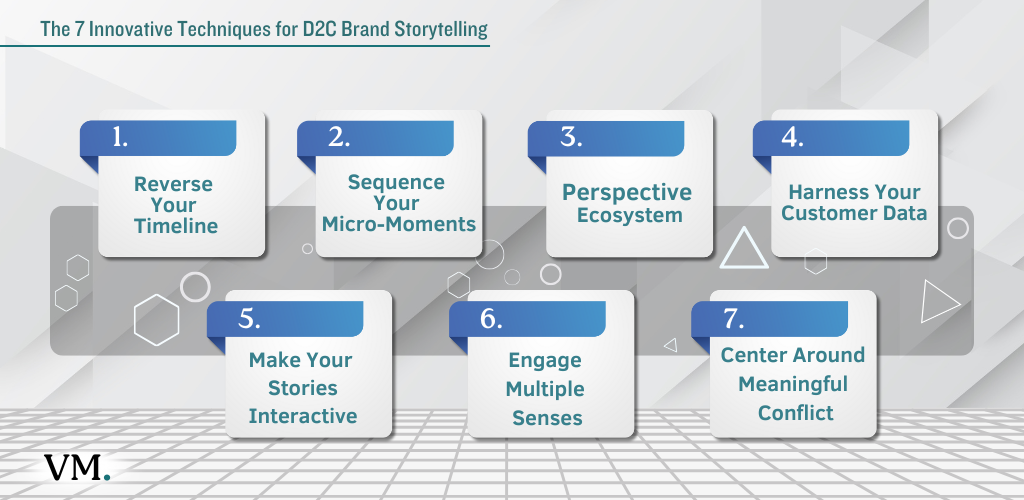Are you tired of seeing the same predictable brand stories that fail to…do anything?
Direct-to-consumer brands face unprecedented competition for customer attention. With consumers being bombarded by hundreds of similar stories daily, standing out has never been more challenging—or more crucial.
Imagine having a storytelling arsenal that not only captures attention but creates genuine emotional connections that convert browsers into buyers. The difference between forgettable D2C brands and industry disruptors often comes down to their narrative approach.
According to recent research (Source: The Brand Shop) shows that 87% of consumers can recall only 3-4 brand stories from the dozens they encounter each week. Will yours be one of them?
The techniques revealed in this guide go beyond conventional “founder inspiration” narratives to provide you with powerful new ways to captivate your audience, foster brand loyalty, and drive measurable business results. By implementing these proven storytelling methods, you’ll create distinctive, memorable experiences that transform how customers perceive both your brand and themselves.
Ready to turn your brand story with one of these unique D2C brand storytelling techniques into your most defensible competitive advantage?
Let’s dive into the strategies that the most successful D2C brands are using right now.
What is D2C Brand Storytelling?
D2C brand storytelling is the strategic craft of creating compelling narratives that connect your direct-to-consumer brand directly with your audience, bypassing traditional retail channels and intermediaries.
Unlike conventional marketing, effective D2C storytelling goes beyond product features or founder journeys to forge meaningful emotional connections that drive customer engagement and loyalty.
Reasons You Need to Know Advanced D2C Storytelling Techniques
Most direct-to-consumer brands are still stuck in outdated storytelling approaches that simply don’t cut through the noise anymore. The digital landscape has evolved, and so have consumer expectations.
-
- Traditional brand narratives are becoming increasingly indistinguishable from one another
-
- Modern consumers crave authentic, distinctive stories that resonate with their personal values
-
- Effective storytelling directly impacts key metrics like conversion rates, average order value, and customer lifetime value
-
- Your brand story has become your most defensible competitive advantage in a market where products can be easily replicated
-
- Innovative narrative approaches create deeper emotional connections that transform customers into brand ambassadors
The seven unique techniques outlined below represent a paradigm shift in how successful D2C brands communicate with their audiences. By implementing these strategies, you’ll create a storytelling advantage that drives sustainable growth in today’s competitive direct-to-consumer landscape.

Step-by-Step Instructions to Transform Your D2C Brand Storytelling
Creating compelling brand narratives doesn’t happen by accident. The most successful D2C brands follow a deliberate process that transcends conventional storytelling wisdom.
Here’s how you can implement a unique storytelling approach that will set your brand apart.
-
- Reverse Your Timeline
- Build a Multi-Perspective Ecosystem
- Harness Your Customer Data
- Sequence Your Micro-Moments
- Engage Multiple Senses
- Center Around Meaningful Conflict
- Make Your Stories Interactive
Let’s explore each of these innovative techniques in detail so you can start implementing them in your own D2C brand strategy.
1. Reverse Your Timeline
Traditional narratives follow a predictable linear progression. Reverse-chronology storytelling flips this approach by beginning with the end result and working backward to reveal how it came to be.
This technique immediately showcases customer transformation, creating intrigue about the journey that led there. By starting with compelling “after” testimonials or results, you create immediate interest in the process behind the transformation.
Implementation requires:
-
- Leading with powerful customer outcomes or “after” stories
-
- Using timestamps or visual cues to guide the audience backward through the narrative
-
- Gradually revealing challenges and turning points along the journey
-
- Incorporating user-generated content showing the transformation process
For example, sustainable fashion brand Reformation effectively uses this technique by showing their finished garments first, then revealing the environmental impact story in reverse—from wearing to manufacturing to material sourcing—highlighting their disruption of traditional retail channels through values-driven production.
To measure effectiveness, track website traffic and engagement time on reverse-chronology content compared to your traditional narratives.
2. Build a Multi-Perspective Ecosystem
Instead of telling a single unified brand story, this technique creates anecosystem of interconnected narratives from different perspectives—founder, customers, employees, community members—each adding a distinct dimension to your brand identity.
This approach creates multiple entry points for different segments of your audience to connect with your brand and validates your unique value proposition through diverse voices.
To implement this strategy:
-
- Map out 3-5 key stakeholder perspectives relevant to your brand values
-
- Develop individual narrative threads for each perspective
-
- Create content that allows these stories to intersect and reinforce each other
-
- Distribute across different channels and formats, ensuring consistency across platforms
Skincare brand Glossier masterfully employs this technique by weaving together narratives from their product developers, dermatologists, diverse customers, and brand ambassadors into a cohesive yet multi-faceted brand universe that fosters community building.
For measurement, analyze which perspective resonates best with different customer segments to refine your targeting and content development strategy.
3. Harness Your Customer Data
Data-driven personalized storytelling uses customer purchase history and behavioral insights to construct personalized story experiences that evolve based on individual interactions with your brand.
This technique creates hyper-relevant narratives that speak directly to each customer’s unique needs and pain points while demonstrating your brand’s attention to detail and commitment to customer satisfaction.
Implementation requires:
-
- Segmenting your audience based on behavioral and preference data
-
- Creating modular story components that can be assembled differently for each segment
-
- Implementing dynamic content delivery systems that adapt narratives based on engagement
-
- Continuously refining storytelling based on performance metrics
Clothing subscription service Stitch Fix exemplifies this approach by using customer data to create personalized “style stories” for each subscriber, explaining why specific items were selected for them and how these pieces connect to their unique style journey—significantly improving customer loyalty and lifetime value.
Compare conversion rates between customers who receive these data-driven narratives versus those who see static content to measure effectiveness.
4. Sequence Your Micro-Moments
Rather than attempting to tell your complete brand story at once, the micro-moment storytelling technique breaks your narrative into strategic fragments delivered at key moments in the customer experience journey.
This method matches storytelling to customer mindset at each stage, building emotional connections gradually without overwhelming potential customers with too much information at once.
To implement this approach:
-
- Map your customer journey identifying critical decision and emotion points
-
- Develop 15-30 second story fragments tailored to each micro-moment
-
- Create a consistent narrative thread that builds across touchpoints
-
- Use visual and verbal cues to link the fragments together cohesively
Dollar Shave Club excels at micro-moment storytelling by delivering different narrative fragments across unboxing experiences, email follow-ups, and replenishment reminders—each adding dimension to their brand personality while driving repeat purchases.
Track completion rates across your entire micro-moment sequence to identify where audience engagement might drop off, providing valuable insights for optimization.
5. Engage Multiple Senses
Sensory storytelling transcends visual elements to engage multiple senses through innovative digital approximations—sound design, texture visualization, color psychology, and implied sensations.
This technique creates more immersive, memorable experiences that overcome the limitations of digital-only interactions and create stronger emotional connections with your audience.
Implementation strategies include:
-
- Identifying your brand’s unique sensory signatures (textures, sounds, etc.)
-
- Developing narratives that trigger cross-sensory associations
-
- Using ASMR techniques, high-definition textures, and evocative language
-
- Creating “sensory bridges” between digital content and physical product experiences
Candle brand Otherland creates sophisticated digital sensory stories using sound design paired with vivid imagery and poetic descriptions that make customers almost smell the product through their screens, creating powerful anticipation for the actual product experience.
Survey customers on sensory recall of your brand to measure how effectively your storytelling creates lasting impressions.
6. Center Around Meaningful Conflict
Rather than portraying your brand as the perfect hero, conflict-centered brand narratives position your brand within larger tensions or conflicts in society, culture, or industry—showing how you navigate or address these complex issues.
This approach demonstrates authenticity and creates deeper relevance by connecting your brand to meaningful issues beyond just product benefits, fostering brand advocacy among value-aligned customers.
To implement this strategy:
-
- Identify legitimate tensions relevant to your product category or audience
-
- Articulate your brand values authentically without oversimplifying complex issues
-
- Show how your products/services engage with these tensions meaningfully
-
- Balance problem acknowledgment with constructive solutions
Patagonia masterfully employs conflict-centered storytelling by addressing environmental degradation head-on—even acknowledging their own contributions—while showing how their practices attempt to mitigate impact, creating compelling stories that resonate with environmentally conscious consumers.
Monitor customer sentiment around your conflict-centered content to ensure it resonates appropriately with your audience and strengthens rather than weakens brand perception.
7. Make Your Stories Interactive
Interactive choice-driven narratives put audience members in control of how the story unfolds, allowing them to make choices that determine the narrative direction through social media, mobile apps, or website interactions.
This technique creates active engagement rather than passive consumption and helps customers self-identify their needs and preferences through story choices, providing valuable insights for future marketing efforts.
Implementation requires:
-
- Creating branching narrative pathways with meaningful choice points
-
- Ensuring each pathway leads to valuable content regardless of choices made
-
- Using interactive elements that feel natural on various devices
-
- Capturing choice data to better understand customer preferences
Beauty brand Function of Beauty uses interactive storytelling to guide customers through creating personalized haircare formulations—each choice revealing more about their product while building a personal narrative about the customer’s unique needs and increasing average order value.
Analyze which narrative pathways lead to highest conversion rates and customer lifetime value to optimize both your storytelling approach and product offerings.

Key Considerations For Successfully Implementing Advanced D2C Storytelling
While each of these techniques is powerful on its own, the most successful D2C brands understand that implementation requires a systematic approach.
The UNIQUE framework provides a structured method for implementing these storytelling techniques effectively:
-
- Understand your target audience’s existing narrative associations
- Narrow your storytelling focus to a single distinctive approach
- Integrate the approach across multiple touchpoints
- Quantify your storytelling impact through relevant KPIs
- Update and evolve your narrative based on customer feedback
- Evaluate competitive storytelling regularly to maintain distinctivenessRemember that storytelling isn’t just about creativity—it’s about creating measurable business impact.
Track key metrics like:
-
- engagement time
-
- conversion rates
-
- average order value
-
- customer lifetime value
to assess the effectiveness of your narrative approaches.
Taking it to the Next Level: How to Build a Comprehensive Storytelling Ecosystem
Once you’ve mastered individual storytelling techniques, the next level involves creating an integrated storytelling ecosystem where different narrative approaches work together harmoniously across the customer journey.
This might involve using reverse-chronology storytelling for acquisition, data-driven personalized storytelling for conversion, and micro-moment sequences for retention—all while maintaining a consistent brand voice and identity.
The most sophisticated D2C brands seamlessly blend these techniques into a coherent experience that feels natural rather than formulaic.
Consider developing a storytelling playbook for your brand that maps specific narrative techniques to different stages of the customer journey, audience segments, and business objectives.
This strategic approach ensures that every story element serves a specific purpose while contributing to your overarching brand narrative.
Alternatives to Advanced Storytelling Techniques
While the techniques outlined above represent cutting-edge approaches to D2C brand storytelling, they aren’t the only options available. Some brands find success with simpler, more traditional approaches like hero’s journey narratives, behind-the-scenes content, or straightforward testimonials.
The key is authenticity—whatever storytelling approach you choose must align with your brand values and resonate with your specific audience. Sometimes a well-executed traditional narrative can outperform a poorly implemented innovative technique. Before adopting any storytelling approach, consider your brand’s unique voice, your audience’s preferences, and your operational capacity to execute consistently across touchpoints.
For resource-constrained startups, focusing on perfecting one distinctive storytelling approach may yield better results than attempting to implement multiple techniques simultaneously.
You can always expand your narrative repertoire as your brand matures.
Summary
In today’s competitive direct-to-consumer landscape, the difference between forgettable brands and category leaders often comes down to storytelling.
The most successful D2C brands aren’t just selling products—they’re creating compelling narratives that transform how customers perceive themselves and the world around them.
By implementing these seven unconventional D2C brand storytelling techniques, your brand can create distinctive, memorable experiences that drive customer engagement, foster emotional connections, and ultimately improve business results across key metrics.
Remember: In a world where products can be easily replicated, your brand story is your most defensible competitive advantage. While your competitors continue recycling the same tired narrative approaches, your brand can pioneer new storytelling territories that capture imagination, build community, and ultimately drive sustainable growth.
The most successful direct-to-consumer brands understand that compelling storytelling is not just about marketing—it’s about creating deeper emotional connections that turn customers into passionate brand ambassadors.
Dario’s Experience With Unique D2C Brand Storytelling Techniques
During my time at Eric Javits, I mastered the art of luxury brand storytelling, blending heritage with modern D2C marketing strategies to drive engagement and sales. Crafting compelling narratives around high-end fashion accessories, I helped transform product descriptions into immersive experiences, resonating deeply with discerning customers.
I leveraged data-driven insights to optimize content for conversion, using storytelling as a growth tool—not just a branding exercise. From social media campaigns to email funnels, I created content that didn’t just inform but emotionally connected, building a community around the brand.
One of my key achievements was revamping the e-commerce content strategy to enhance customer journey touchpoints, leading to higher engagement and increased direct-to-consumer revenue.
This experience solidified my approach: Luxury isn’t just about the product; it’s about how the story makes people feel.
I now apply this expertise to other D2C brands, helping them create magnetic storytelling techniques that drive both brand loyalty and conversions.
Want to transform your brand’s story into a powerful D2C growth engine? Let’s connect!
Reach out today and let’s craft a strategy with Dario that turns your vision into reality.
FAQ
What are interactive storytelling experiences and how do they drive engagement?
Interactive storytelling experiences involve immersive content types like polls, quizzes, and augmented reality (AR) that encourage active participation from the audience.
This interactivity fosters deeper engagement and creates memorable brand experiences that drive conversion and loyalty.
Why is personalized storytelling important for targeting specific audience segments?
Personalized storytelling tailors brand narratives to resonate with specific audience segments based on their preferences and characteristics.
Analyzing consumer behavior data allows D2C brands to craft messages that speak directly to distinct target groups, increasing relevance and engagement.
How can user-generated content contribute to authentic brand storytelling?
Incorporating user-generated content into brand narratives establishes trust and authenticity among consumers.
Encouraging customers to share their stories creates a sense of community and enhances engagement levels on social media platforms.
What role does visual storytelling play in engaging audiences for D2C brands?
Visual storytelling enhances understanding and retention of brand narratives.
Different forms of visual content such as videos, images, and infographics can be utilized to captivate audiences, making the storytelling experience more engaging and impactful.
How can emotional connections enhance brand loyalty in D2C storytelling?
Emotional connections are significant in branding because they allow consumers to relate to the brand on a personal level.
By centering customers as main characters in brand stories, D2C brands can enhance relatability and foster deeper connections, ultimately driving customer loyalty.



